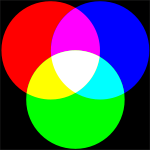From Wikipedia, the free encyclopedia.
The RGB color model is an additive color model in which red, green, and blue light are added together in various ways to reproduce a broad array of colors. The name of the model comes from the initials of the three additive primary colors, red, green, and blue.
The main purpose of the RGB color model is for the sensing, representation, and display of images in electronic systems, such as televisions and computers, though it has also been used in conventional photography. Before the electronic age, the RGB color model already had a solid theory behind it, based in human perception of colors.
RGB is a device-dependent color model: different devices detect or reproduce a given RGB value differently, since the color elements (such as phosphors or dyes) and their response to the individual R, G, and B levels vary from manufacturer to manufacturer, or even in the same device over time. Thus an RGB value does not define the same color across devices without some kind of color management.
Typical RGB input devices are color TV and video cameras, image scanners, video games, and digital cameras. Typical RGB output devices are TV sets of various technologies (CRT, LCD, plasma, etc.), computer and mobile phone displays, video projectors, multicolor LED displays, and large screens such as JumboTron. Color printers, on the other hand, are not RGB devices, but subtractive color devices (typically CMYK color model).
This article discusses concepts common to all the different color spaces that use the RGB color model, which are used in one implementation or another in color image-producing technology.
Da Wikipedia, l'enciclopedia libera.
RGB è il nome di un modello di colori le cui specifiche sono state descritte nel 1931 dalla CIE (Commission internationale de l'éclairage). Tale modello di colori è di tipo additivo e si basa sui tre colori rosso (Red), verde (Green) e blu (Blue), da cui appunto il nome RGB, da non confondere con i colori primari sottrattivi giallo, ciano e magenta.
Additive primary colors
To form a color with RGB, three colored light beams (one red, one green, and one blue) must be superimposed (for example by emission from a black screen, or by reflection from a white screen). Each of the three beams is called a component of that color, and each of them can have an arbitrary intensity, from fully off to fully on, in the mixture.
The RGB color model is additive in the sense that the three light beams are added together, and their light spectra add, wavelength for wavelength, to make the final color's spectrum.[1][2]
Zero intensity for each component gives the darkest color (no light, considered the black), and full intensity of each gives a white; the quality of this white depends on the nature of the primary light sources, but if they are properly balanced, the result is a neutral white matching the system's white point. When the intensities for all the components are the same, the result is a shade of gray, darker or lighter depending on the intensity. When the intensities are different, the result is a colorized hue, more or less saturated depending on the difference of the strongest and weakest of the intensities of the primary colors employed.
When one of the components has the strongest intensity, the color is a hue near this primary color (reddish, greenish, or bluish), and when two components have the same strongest intensity, then the color is a hue of a secondary color (a shade of cyan, magenta or yellow). A secondary color is formed by the sum of two primary colors of equal intensity: cyan is green+blue, magenta is red+blue, and yellow is red+green. Every secondary color is the complement of one primary color; when a primary and its complementary secondary color are added together, the result is white: cyan complements red, magenta complements green, and yellow complements blue.
The RGB color model itself does not define what is meant by red, green, and blue colorimetrically, and so the results of mixing them are not specified as absolute, but relative to the primary colors. When the exact chromaticities of the red, green, and blue primaries are defined, the color model then becomes an absolute color space, such as sRGB or Adobe RGB; see RGB color spaces for more details.
Descrizione
Un'immagine può infatti essere scomposta, attraverso
filtri o altre tecniche, in questi colori base che miscelati tra loro
danno quasi tutto lo spettro dei colori visibili, con l'eccezione delle
porpore.
Più specificamente i 3 colori principali corrispondo a forme d'onda (radiazioni luminose) di periodo fissato, quali:
Rosso, con una lunghezza d'onda di 700 nm
Verde, con una lunghezza d'onda di 546,1 nm
Blu, con una lunghezza d'onda di 455,8 nm
L'RGB è un modello additivo: unendo i tre colori con la
loro intensità massima si ottiene il bianco (tutta la luce viene
riflessa). La combinazione delle coppie di colori dà il cìano, il
magenta e il giallo.
Physical principles for the choice of red, green, and blue
The choice of primary colors is related to the physiology of the human eye; good primaries are stimuli that maximize the difference between the responses of the cone cells of the human retina to light of different wavelengths, and that thereby make a large color triangle.
The normal three kinds of light-sensitive photoreceptor cells in the human eye (cone cells) respond most to yellow (long wavelength or L), green (medium or M), and violet (short or S) light (peak wavelengths near 570 nm, 540 nm and 440 nm, respectively). The difference in the signals received from the three kinds allows the brain to differentiate a wide gamut of different colors, while being most sensitive (overall) to yellowish-green light and to differences between hues in the green-to-orange region.
As an example, suppose that light in the orange range of wavelengths (approximately 577 nm to 597 nm) enters the eye and strikes the retina. Light of these wavelengths would activate both the medium and long wavelength cones of the retina, but not equally—the long-wavelength cells will respond more. The difference in the response can be detected by the brain, and this difference is the basis of our perception of orange. Thus, the orange appearance of an object results from light from the object entering our eye and stimulating the different cones simultaneously but to different degrees.
Use of the three primary colors is not sufficient to reproduce all colors; only colors within the color triangle defined by the chromaticities of the primaries can be reproduced by additive mixing of non-negative amounts of those colors of light.
Per poter trasferire un'immagine video è necessario
inviare anche un segnale di sincronismo che fornisca le informazioni su
quando inizia un'immagine (sincronismo verticale) e su quando inizia una
riga dell'immagine (sincronismo orizzontale). Questi due sincronismi
possono essere combinati in un unico sincronismo (sincronismo
composito).
Principi fisici per la scelta del rosso, verde e blu
La scelta dei colori primari è correlata alla fisiologia
dell'occhio umano; buoni primari sono stimoli che massimizzano la
differenza tra le risposte delle cellule cono della retina alle
differenze di lunghezza d'onda della luce, cioè hanno un triangolo di
colore esteso.
I tre tipi normali di cellule fotorecettive sensibili
alla luce nell'occhio umano (le cellule cono) rispondono più alla luce
blu (lunghezza d'onda lunga), verde (media), e rossa (corta), con picchi
vicini ai 570 nm, 540 nm e 440 nm, rispettivamente. La differenza nei
segnali ricevuti dai tre tipi permette al cervello di differenziare un
largo gamut di colori diversi, essendo più sensibile soprattutto alla
luce verde-giallognola e alle differenze di tonalità nella regione
verde-arancione.
L'uso dei tre colori primari non è sufficiente a
riprodurre tutti i colori; solo i colori entro il triangolo dei colori
definito dalla cromaticità dei primari possono essere riprodotti tramite
sintesi additiva di quantità non negative di tali colori.



